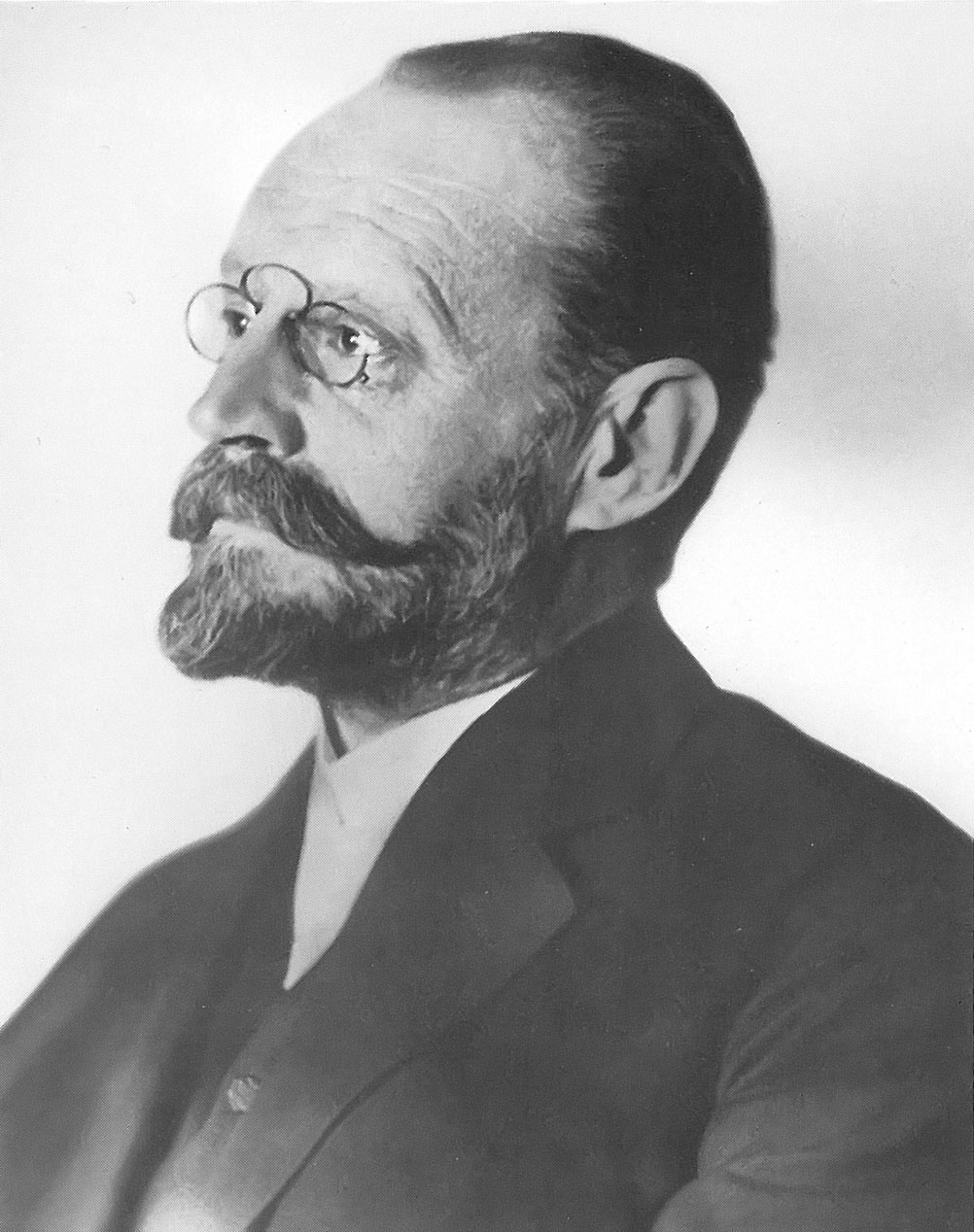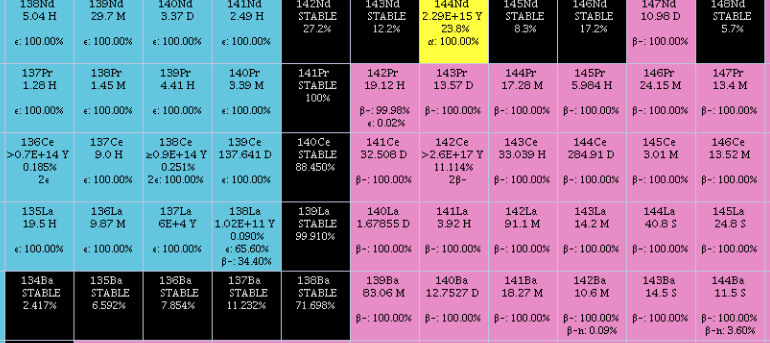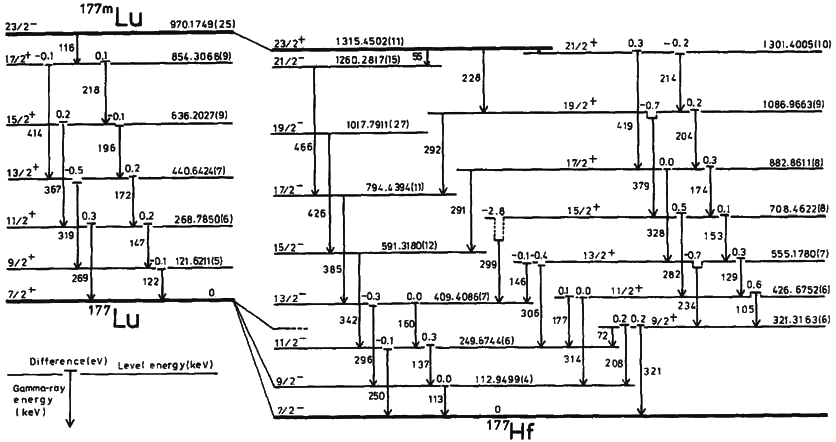|
Isotopes Of Praseodymium
Naturally occurring praseodymium (59Pr) is composed of one stable isotope, 141Pr. Thirty-eight radioisotopes have been characterized with the most stable being 143Pr, with a half-life of 13.57 days and 142Pr, with a half-life of 19.12 hours. All of the remaining radioactive isotopes have half-lives that are less than six hours and the majority of these have half-lives that are less than 33 seconds. This element also has 15 meta states with the most stable being 138mPr (t1/2 2.12 hours), 142mPr (t1/2 14.6 minutes) and 134mPr (t1/2 11 minutes). The isotopes of praseodymium range in atomic weight from (121Pr) to (159Pr). The primary decay mode before the stable isotope, 141Pr, is electron capture and the mode after is beta decay. The primary decay products before 141Pr are element 58 (cerium) isotopes and the primary products after are element 60 (neodymium) isotopes. List of isotopes , -id=Praseodymium-121 , 121Pr , style="text-align:right" , 59 , style="text-align:righ ... [...More Info...] [...Related Items...] OR: [Wikipedia] [Google] [Baidu] |
Praseodymium
Praseodymium is a chemical element; it has symbol Pr and atomic number 59. It is the third member of the lanthanide series and is considered one of the rare-earth metals. It is a soft, silvery, malleable and ductile metal, valued for its magnetic, electrical, chemical, and optical properties. It is too reactive to be found in native form, and pure praseodymium metal slowly develops a green oxide coating when exposed to air. Praseodymium always occurs naturally together with the other rare-earth metals. It is the sixth-most abundant rare-earth element and fourth-most abundant lanthanide, making up 9.1 parts per million of the Earth's crust, an abundance similar to that of boron. In 1841, Swedish chemist Carl Gustav Mosander extracted a rare-earth oxide residue he called didymium from a residue he called "lanthana", in turn separated from cerium salts. In 1885, the Austrian chemist Carl Auer von Welsbach separated didymium into two elements that gave salts of different colours, ... [...More Info...] [...Related Items...] OR: [Wikipedia] [Google] [Baidu] |
Neodymium
Neodymium is a chemical element; it has Symbol (chemistry), symbol Nd and atomic number 60. It is the fourth member of the lanthanide series and is considered to be one of the rare-earth element, rare-earth metals. It is a hard (physics), hard, slightly malleable, silvery metal that quickly tarnishes in air and moisture. When oxidized, neodymium reacts quickly producing pink, purple/blue and yellow compounds in the +2, +3 and +4 oxidation states. It is generally regarded as having one of the most complex emission spectrum, spectra of the elements. Neodymium was discovered in 1885 by the Austrian chemist Carl Auer von Welsbach, who also discovered praseodymium. Neodymium is present in significant quantities in the minerals monazite and bastnäsite. Neodymium is not found naturally in metallic form or unmixed with other lanthanides, and it is usually refined for general use. Neodymium is fairly common—about as common as cobalt, nickel, or copper—and is Abundance of elements in Eart ... [...More Info...] [...Related Items...] OR: [Wikipedia] [Google] [Baidu] |
Isotopes Of Praseodymium
Naturally occurring praseodymium (59Pr) is composed of one stable isotope, 141Pr. Thirty-eight radioisotopes have been characterized with the most stable being 143Pr, with a half-life of 13.57 days and 142Pr, with a half-life of 19.12 hours. All of the remaining radioactive isotopes have half-lives that are less than six hours and the majority of these have half-lives that are less than 33 seconds. This element also has 15 meta states with the most stable being 138mPr (t1/2 2.12 hours), 142mPr (t1/2 14.6 minutes) and 134mPr (t1/2 11 minutes). The isotopes of praseodymium range in atomic weight from (121Pr) to (159Pr). The primary decay mode before the stable isotope, 141Pr, is electron capture and the mode after is beta decay. The primary decay products before 141Pr are element 58 (cerium) isotopes and the primary products after are element 60 (neodymium) isotopes. List of isotopes , -id=Praseodymium-121 , 121Pr , style="text-align:right" , 59 , style="text-align:righ ... [...More Info...] [...Related Items...] OR: [Wikipedia] [Google] [Baidu] |
Isotopes Of Lanthanum
Naturally occurring lanthanum (57La) is composed of one stable (139La) and one radioactive (138La) isotope, with the stable isotope, 139La, being the most abundant (99.91% natural abundance). There are 39 radioisotopes that have been characterized, with the most stable being 138La, with a half-life of 1.03×1011 years; 137La, with a half-life of 60,000 years and 140La, with a half-life of 1.6781 days. The remaining radioactive isotopes have half-lives that are less than a day and the majority of these have half-lives that are less than 1 minute. This element also has 12 nuclear isomers, the longest-lived of which is 132mLa, with a half-life of 24.3 minutes. Lighter isotopes mostly decay to isotopes of barium and heavy ones mostly decay to isotopes of cerium. 138La can decay to both. The isotopes of lanthanum range in atomic weight from 115.96 u (116La) to 154.96 u (155La). List of isotopes , -id=Lanthanum-116 , rowspan=2, 116La , rowspan=2 style="text-align:r ... [...More Info...] [...Related Items...] OR: [Wikipedia] [Google] [Baidu] |
Isotopes Of Cerium
Naturally occurring cerium (58Ce) is composed of 4 stable isotopes: 136Ce, 138Ce, 140Ce, and 142Ce, with 140Ce being the most abundant (88.48% natural abundance) and the only one theoretically stable; 136Ce, 138Ce, and 142Ce are predicted to undergo double beta decay but this process has never been observed. There are 35 radioisotopes that have been characterized, with the most stable being 144Ce, with a half-life of 284.893 days; 139Ce, with a half-life of 137.640 days and 141Ce, with a half-life of 32.501 days. All of the remaining radioactive isotopes have half-lives that are less than 4 days and the majority of these have half-lives that are less than 10 minutes. This element also has 10 meta states. The isotopes of cerium range in atomic weight from 119 u (119Ce) to 157 u (157Ce). List of isotopes , -id=Cerium-121 , rowspan=2, 121Ce , rowspan=2 style="text-align:right" , 58 , rowspan=2 style="text-align:right" , 63 , rowspan=2, 120.94344(43)# , rowspan=2, ... [...More Info...] [...Related Items...] OR: [Wikipedia] [Google] [Baidu] |
Isotopes Of Neodymium
Naturally occurring neodymium (60Nd) is composed of five stable isotopes, 142Nd, 143Nd, 145Nd, 146Nd and 148Nd, with 142Nd being the most abundant (27.2% natural abundance), and two long-lived radioisotopes, 144Nd and 150Nd. In all, 35 radioisotopes of neodymium have been characterized up to now, with the most stable being naturally occurring isotopes 144Nd (alpha decay, a half-life (t1/2) of years) and 150Nd (double beta decay, t1/2 of years), and for practical purposes they can be considered to be stable as well. All of the remaining radioactive isotopes have half-lives that are less than 11 days, and the majority of these have half-lives that are less than 70 seconds; the most stable synthetic radioisotope, artificial isotope is 147Nd with a half-life of 10.98 days. This element also has 15 known meta states with the most stable being 139mNd (t1/2 5.5 hours), 135mNd (t1/2 5.5 minutes) and 133m1Nd (t1/2 ~70 seconds). The primary decay modes for isotopes lighter than the most ab ... [...More Info...] [...Related Items...] OR: [Wikipedia] [Google] [Baidu] |
Fission Product
Nuclear fission products are the atomic fragments left after a large atomic nucleus undergoes nuclear fission. Typically, a large nucleus like that of uranium fissions by splitting into two smaller nuclei, along with a few neutrons, the release of heat energy (kinetic energy of the nuclei), and gamma rays. The two smaller nuclei are the ''fission products''. (See also Fission products (by element)). About 0.2% to 0.4% of fissions are ternary fissions, producing a third light nucleus such as helium-4 (90%) or tritium (7%). The fission products themselves are usually unstable and therefore radioactive. Due to being relatively neutron-rich for their atomic number, many of them quickly undergo beta decay. This releases additional energy in the form of beta particles, antineutrinos, and gamma rays. Thus, fission events normally result in beta and additional gamma radiation that begins immediately after, even though this radiation is not produced directly by the fission even ... [...More Info...] [...Related Items...] OR: [Wikipedia] [Google] [Baidu] |
Electron Capture
Electron capture (K-electron capture, also K-capture, or L-electron capture, L-capture) is a process in which the proton-rich nucleus of an electrically neutral atom absorbs an inner atomic electron, usually from the K or L electron shells. This process thereby changes a nuclear proton to a neutron and simultaneously causes the emission of an electron neutrino. : : or when written as a nuclear reaction equation, ^_e + ^_p -> ^_n + ^_ ν_e Since this single emitted neutrino carries the entire decay energy, it has this single characteristic energy. Similarly, the momentum of the neutrino emission causes the daughter atom to recoil with a single characteristic momentum. The resulting daughter nuclide, if it is in an excited state, then transitions to its ground state. Usually, a gamma ray is emitted during this transition, but nuclear de-excitation may also take place by internal conversion. Following capture of an inner electron from the atom, an outer elect ... [...More Info...] [...Related Items...] OR: [Wikipedia] [Google] [Baidu] |
Isomeric Transition
A nuclear isomer is a metastable state of an atomic nucleus, in which one or more nucleons (protons or neutrons) occupy excited state levels (higher energy levels). "Metastable" describes nuclei whose excited states have half-lives of 10−9 seconds or longer, 100 to 1000 times longer than the half-lives of the excited nuclear states that decay with a "prompt" half life (ordinarily on the order of 10−12 seconds). Some references recommend seconds to distinguish the metastable half life from the normal "prompt" gamma-emission half-life. Occasionally the half-lives are far longer than this and can last minutes, hours, or years. For example, the nuclear isomer survives so long (at least years) that it has never been observed to decay spontaneously. The half-life of a nuclear isomer can even exceed that of the ground state of the same nuclide, as shown by as well as , , , , and multiple holmium isomers. Sometimes, the gamma decay from a metastable state is referred ... [...More Info...] [...Related Items...] OR: [Wikipedia] [Google] [Baidu] |
Proton Emission
Proton emission (also known as proton radioactivity) is a rare type of radioactive decay in which a proton is ejected from a atomic nucleus, nucleus. Proton emission can occur from high-lying excited states in a nucleus following a beta decay, in which case the process is known as beta-delayed proton emission, or can occur from the ground state (or a low-lying nuclear isomer, isomer) of very proton-rich nuclei, in which case the process is very similar to alpha decay. For a proton to escape a nucleus, the proton separation energy must be negative (Sp < 0)—the proton is therefore unbound, and quantum tunneling, tunnels out of the nucleus in a finite time. The rate of proton emission is governed by the nuclear, Coulomb, and centrifugal potentials of the nucleus, where centrifugal potential affects a large part of the rate of proton emission. The half-life of a nucleus with respect to proton emission is affected by the proton energy and its orbital angular momentum. Proton emiss ... [...More Info...] [...Related Items...] OR: [Wikipedia] [Google] [Baidu] |
Cerium
Cerium is a chemical element; it has Chemical symbol, symbol Ce and atomic number 58. It is a hardness, soft, ductile, and silvery-white metal that tarnishes when exposed to air. Cerium is the second element in the lanthanide series, and while it often shows the oxidation state of +3 characteristic of the series, it also has a stable +4 state that does not oxidize water. It is considered one of the rare-earth elements. Cerium has no known biological role in humans but is not particularly toxic, except with intense or continued exposure. Despite always occurring in combination with the other rare-earth elements in minerals such as those of the monazite and bastnäsite groups, cerium is easy to extract from its ores, as it can be distinguished among the lanthanides by its unique ability to be oxidized to the +4 state in aqueous solution. It is the most common of the lanthanides, followed by neodymium, lanthanum, and praseodymium. Its estimated abundance of elements in Earth's crust, ... [...More Info...] [...Related Items...] OR: [Wikipedia] [Google] [Baidu] |



